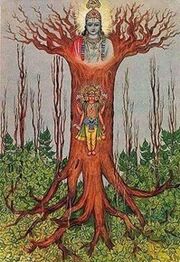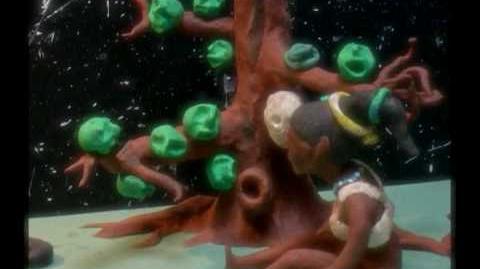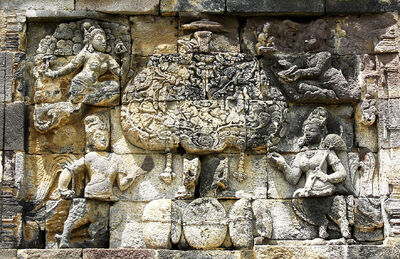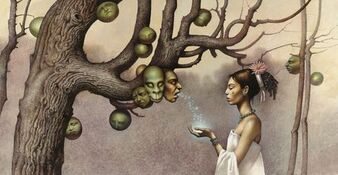
A Hindu Cosmic Tree
Akshayavat or Akshay Vat ("the indestructible banyan tree") is a sacred Cosmic Tree mentioned in Hindu and Buddhist mythology.
Cosmic Trees[]
- Main article: Cosmic Tree
World trees or cosmic trees are a prevalent motif occurring in the mythical cosmologies, creation accounts, and

The Hero Twins Part 1
Cosmic Tree from Mayan Hero Twins Myth
iconographies most notable in the pre-Columbian cultures of Mesoamerica. In the Mesoamerican context, world trees embodied the four cardinal directions, which also serve to represent the fourfold nature of a central world tree, a symbolic axis mundi which connects the planes of the Underworld and the sky with that of the terrestrial realm.
Description[]
According to Tibetan Buddhist tradition, Buddha is said to have planted a seed of the Prayag's Akshayavat next to

Mount Kailash on a mountain known as the Palace of the Medicine Buddha. A sacred fig tree located within the Patalpuri Temple at the Allahabad Fort is worshipped as the Akshayavat by some Hindus. As of 2011, a permission from the Commandant of Allahabad Fort's Ordnance Depot is needed to visit this tree. On one day during the Kumbh Mela, the site is open to all the pilgrims.
According to the local belief, the sage Shukdeva narrated Srimad Bhagavatam to the king Parikshit under this tree.
In The Encyclopaedia Asiatica (1976),

Cosmic Tree from the Mayan "Hero Twins" Myth
Edward Balfour identifies a banyan tree mentioned in Ramayana with this tree at Prayag, Allahabad. Rama, Lakshmana and Sita are said to have rested beneath this tree.
The Chinese Buddhist pilgrim Xuanzang mentions a tree (a stump with few branches) which was said to be the home of a man-eating demon. As part of a custom, some pilgrims would offer themselves at the nearby temple. Tsang mentions that the tree was surrounded with the human bones. General Cunnigham identifies this tree with the Akshayavat. Rishabha (Jain tirthankar) is also said to have practised tapasya beneath the historical Akshayavata at Prayag.
